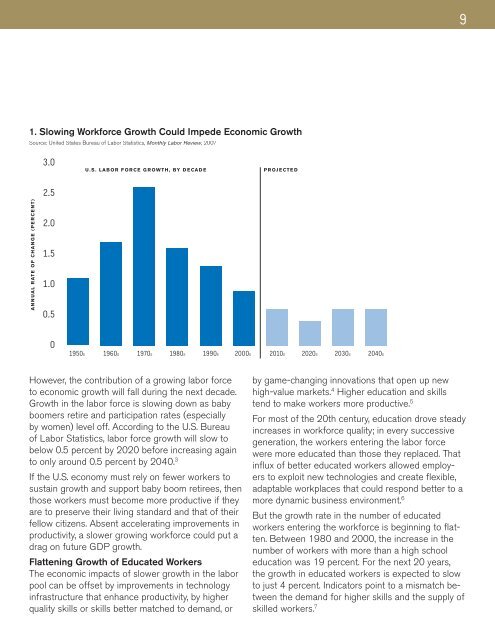Thrive: The Skills Imperative - Power Systems Engineering ...
Thrive: The Skills Imperative - Power Systems Engineering ...
Thrive: The Skills Imperative - Power Systems Engineering ...
You also want an ePaper? Increase the reach of your titles
YUMPU automatically turns print PDFs into web optimized ePapers that Google loves.
9<br />
1. Slowing Workforce Growth Could Impede Economic Growth<br />
Source: United States Bureau of Labor Statistics, Monthly Labor Review, 2007<br />
<br />
U.S. LABOR FORCE GROWTH, BY DECADE<br />
PROJECTED<br />
<br />
ANNUAL RATE OF CHANGE (PERCENT)<br />
<br />
<br />
<br />
<br />
<br />
s s s s s s s s s s<br />
However, the contribution of a growing labor force<br />
to economic growth will fall during the next decade.<br />
Growth in the labor force is slowing down as baby<br />
boomers retire and participation rates (especially<br />
by women) level off. According to the U.S. Bureau<br />
of Labor Statistics, labor force growth will slow to<br />
below 0.5 percent by 2020 before increasing again<br />
to only around 0.5 percent by 2040. 3<br />
If the U.S. economy must rely on fewer workers to<br />
sustain growth and support baby boom retirees, then<br />
those workers must become more productive if they<br />
are to preserve their living standard and that of their<br />
fellow citizens. Absent accelerating improvements in<br />
productivity, a slower growing workforce could put a<br />
drag on future GDP growth.<br />
Flattening Growth of Educated Workers<br />
<strong>The</strong> economic impacts of slower growth in the labor<br />
pool can be offset by improvements in technology<br />
infrastructure that enhance productivity, by higher<br />
quality skills or skills better matched to demand, or<br />
by game-changing innovations that open up new<br />
high-value markets. 4 Higher education and skills<br />
tend to make workers more productive. 5<br />
For most of the 20th century, education drove steady<br />
increases in workforce quality; in every successive<br />
generation, the workers entering the labor force<br />
were more educated than those they replaced. That<br />
influx of better educated workers allowed employers<br />
to exploit new technologies and create flexible,<br />
adaptable workplaces that could respond better to a<br />
more dynamic business environment. 6<br />
But the growth rate in the number of educated<br />
workers entering the workforce is beginning to flatten.<br />
Between 1980 and 2000, the increase in the<br />
number of workers with more than a high school<br />
education was 19 percent. For the next 20 years,<br />
the growth in educated workers is expected to slow<br />
to just 4 percent. Indicators point to a mismatch between<br />
the demand for higher skills and the supply of<br />
skilled workers. 7
















